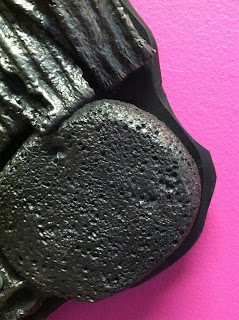As leaves were falling we had the privilege of hosting Zora Palova as International Randall Chair in Sculpture Dimensional Studies.
During her time she worked across media within the Sculpture area producing a beautiful new body of work in neon, glass, paper and cast iron.
Palová, who lives and works in Bratislava, Slovakia, first studied painting and sculpture and then switched to glass, studying with well-known Czech glass sculptor Václav Cigler. She worked independently for 20 years while raising a family before teaching glass sculpture at the University of Sunderland in England. She currently devotes all of her time to creating her own sculptural work.
 |
| 'Empty Seed' Cast Iron + Yellow Felt |
Her
approach to cast glass sculpture is perhaps characteristic of her generation,
which draws from—and breaks with—the ideas developed by the famous Czechoslovak
artists of the postwar era, such as Cigler, Stanislav Libenský, and Jarolslava
Brychtová. Her use of the material is gestural, emotional, and grounded in the
natural world. She works with light, using rough textures and transparent color
in glass.
 |
| Cast Glass, Wax + Iron |
 |
| Paige Henry and Jeremy Hanson on the Ladle: pouring iron at 2650 degree Fahrenheit form the induction furnace |
 |
| Zora Palova and Coral Penelope Lambert with the successfully poured iron 'Leaf' sculpture. |



 |
| Paige Henry at work on the molds for Zora |



Zora expressed how these new processes compliment her studio practice and reinforce her interest in the concepts of fragility versus strength, soft against hard, interior touching exterior and feminine alongside masculine.
 |
| 'LEAF' Cast Iron with Stove Black finish |
 |
| Zora Palova selecting patinas for the finished work: she decided to go with the classic stove black with one and then yellow felt to create a soft interior on another. |
Thank You Zora for visiting the Foundry: We hope to see you again!
Photos by
Zora Palova, Coral Penelope Lambert + Paige Henry






































